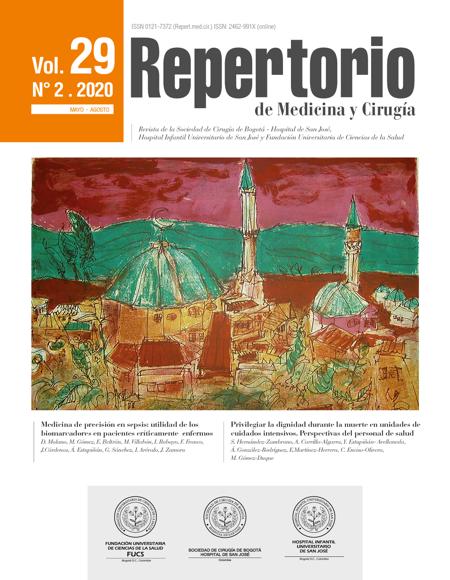The trauma lethal triad as a predictor of death in major trauma patients
Consideraciones sobre la tríada letal para predecir mortalidad en pacientes con trauma mayor
How to Cite
Download Citation
![]()
![]()

Show authors biography
Introduction: trauma is considered a public health problem, and mortality rate is the main indicator of its magnitude. Clinical recognition of the lethal triad components is relevant as a predictor of death in major trauma patients. Objective: to determine the operative features of the lethal triad in patients admitted to the emergency services of the San José and Infantil Universitario de San José Hospitals in Bogota with major trauma injuries, from January 2012 to December 2017, to estimate the probability of death. Methods: a case and control study of results in diagnostic tests during said period in order to evaluate mortality rate in severe cranioencephalic trauma patients. Results: 500 cases were included; the predominant characteristics were brain trauma in 74% of deceased patients and 43.8% of survivors, moderate hypothermia (equal or < 36°C) was evidenced in 98.2% among survivors and in 96% of non-survivors and acidosis in 2.7% of those who survived and 68% of those who died. This lethal triad had a sensibility and specificity of 0.02 and 1, with negative predictive values of 1 and 0.90. Conclusion: The sensitivity of the lethal triad was less than that reported in the literature and specificity was greater with high predictive values, thus it was considered that the triad was non determinant in the mortality rate of severe trauma patients.
Article visits 5260 | PDF visits 1974
Downloads
- Buitrago Jaramillo J. Epidemiologia del trauma. Pereira: Universidad Tecnológica de Pereira; 2014. p. 16.
- Ministerio de Salud y Protección Social. Análisis de Situación de Salud. Colombia, 2016. Colombia: Ministerio de Salud y Protección Social; 2017. p. 163.
- Haddon W, Jr. Energy damage and the ten countermeasure strategies. The Journal of trauma. 1973;13(4):321-31. doi: 10.1097/00005373-197304000-00011. DOI: https://doi.org/10.1097/00005373-197304000-00011
- Trunkey D. Initial treatment of patients with extensive trauma. The New England journal of medicine. 1991;324(18):1259-63. doi: 10.1056/NEJM199105023241806. DOI: https://doi.org/10.1056/NEJM199105023241806
- Morales Wong MM, Gómez Hernández MM, Ramos Godines A, LLanes Mendoza OL, González Ortega JM. La Tríada de la Muerte”. Acidosis, hipotermia y coagulopatías en pacientes con traumas. Rev Méd Electrón. 2007;29(1):56-64.
- González Balverde M, Ramírez Lizardo EJ, Cardona Muñoz EG, Totsuka Sutto SE, García Benavides L. Triada mortal en pacientes politraumatizados, relación con mortalidad y severidad. Revista médica de Chile. 2013;141(11):1420-6. DOI: https://doi.org/10.4067/S0034-98872013001100008
- Keane M. Triad of death: the importance of temperature monitoring in trauma patients. Emergency nurse: the journal of the RCN Accident and Emergency Nursing Association. 2016;24(5):19-23. doi: 10.7748/en.2016.e1569 DOI: https://doi.org/10.7748/en.2016.e1569
- Vincent-Lambert C, Smith CM, Goldstein LN. Hypothermia in trauma patients arriving at an emergency department by ambulance in Johannesburg, South Africa: a prospective study. The Pan African medical journal. 2018;31:136. DOI: https://doi.org/10.11604/pamj.2018.31.136.13615
- Bozorgi F, Khatir IG, Ghanbari H, Jahanian F, Arabi M, Ahidashti HA, et al. Investigation of Frequency of the Lethal Triad and Its 24 Hours Prognostic Value among Patients with Multiple Traumas. Open access Macedonian journal of medical sciences. 2019;7(6):962-6. doi: 10.3889/oamjms.2019.217. DOI: https://doi.org/10.3889/oamjms.2019.217












